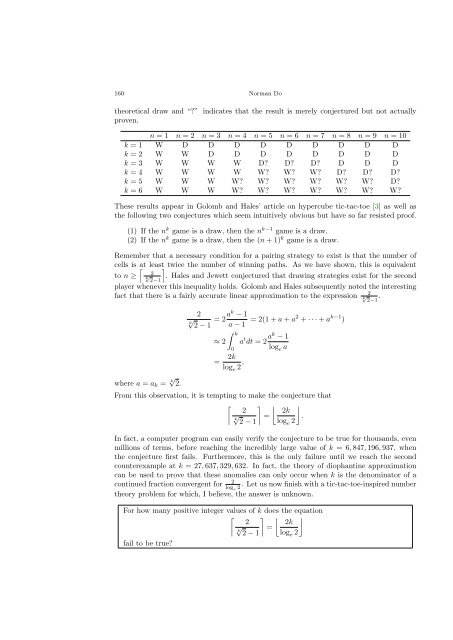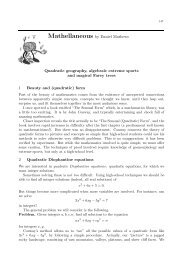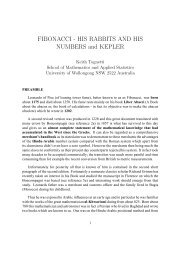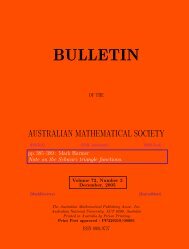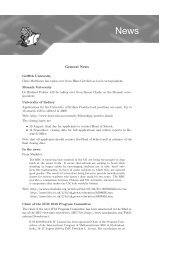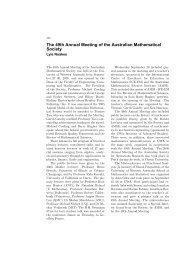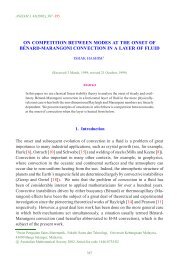Gazette 31 Vol 3 - Australian Mathematical Society
Gazette 31 Vol 3 - Australian Mathematical Society
Gazette 31 Vol 3 - Australian Mathematical Society
You also want an ePaper? Increase the reach of your titles
YUMPU automatically turns print PDFs into web optimized ePapers that Google loves.
160 Norman Do<br />
theoretical draw and “?” indicates that the result is merely conjectured but not actually<br />
proven.<br />
n = 1 n = 2 n = 3 n = 4 n = 5 n = 6 n = 7 n = 8 n = 9 n = 10<br />
k = 1 W D D D D D D D D D<br />
k = 2 W W D D D D D D D D<br />
k = 3 W W W W D? D? D? D D D<br />
k = 4 W W W W W? W? W? D? D? D?<br />
k = 5 W W W W? W? W? W? W? W? D?<br />
k = 6 W W W W? W? W? W? W? W? W?<br />
These results appear in Golomb and Hales’ article on hypercube tic-tac-toe [3] as well as<br />
the following two conjectures which seem intuitively obvious but have so far resisted proof.<br />
(1) If the n k game is a draw, then the n k−1 game is a draw.<br />
(2) If the n k game is a draw, then the (n + 1) k game is a draw.<br />
Remember that a necessary condition for a pairing strategy to exist is that the number of<br />
cells is at least� twice the number of winning paths. As we have shown, this is equivalent<br />
to n ≥ . Hales and Jewett conjectured that drawing strategies exist for the second<br />
�<br />
2<br />
k√<br />
2−1<br />
player whenever this inequality holds. Golomb and Hales subsequently noted the interesting<br />
2<br />
fact that there is a fairly accurate linear approximation to the expression k√ .<br />
2−1<br />
where a = ak = k√ 2.<br />
2<br />
k√ = 2<br />
2 − 1 ak − 1<br />
a − 1 = 2(1 + a + a2 + · · · + a k−1 )<br />
≈ 2<br />
� k<br />
0<br />
= 2k<br />
log e 2 ,<br />
a t dt = 2 ak − 1<br />
log e a<br />
From this observation, it is tempting to make the conjecture that<br />
� � � �<br />
2 2k<br />
k√ = .<br />
2 − 1 loge 2<br />
In fact, a computer program can easily verify the conjecture to be true for thousands, even<br />
millions of terms, before reaching the incredibly large value of k = 6, 847, 196, 937, when<br />
the conjecture first fails. Furthermore, this is the only failure until we reach the second<br />
counterexample at k = 27, 637, 329, 632. In fact, the theory of diophantine approximation<br />
can be used to prove that these anomalies can only occur when k is the denominator of a<br />
2<br />
continued fraction convergent for loge 2 . Let us now finish with a tic-tac-toe-inspired number<br />
theory problem for which, I believe, the answer is unknown.<br />
For how many positive integer values of k does the equation<br />
� � � �<br />
2 2k<br />
k√ =<br />
2 − 1 loge 2<br />
fail to be true?


